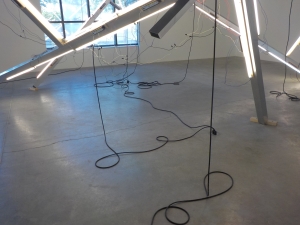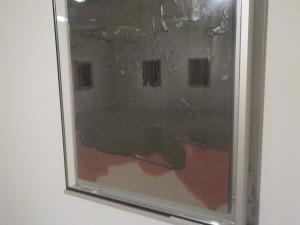In Toronto and elsewhere, the lack of distracting activities like movies, concerts and sports is contributing to profound events. The real world is changing so fast, as people get focused and rise up. Meanwhile, in the cultural domain, time and place, and, openings and closings, don’t really matter. Many cultural products have become digital and are therefore on demand, untethered by time constraints. Time itself can be compressed to almost nothing or drawn out and made to last.
2020 Scotiabank CONTACT Photography Festival
Ho Tam at Paul Petro Contemporary Art
For example, the 2020 Scotiabank Contact Photography Festival, which normally takes place throughout the city in the month of May, was largely postponed, except for the bits and pieces of it which can still be seen, either online or, in a few instances, as outdoor public installations (in the real world.)
In a 25-year-old video by Ho Tam, which was exhibited at Paul Petro Contemporary Art as part of CONTACT, Godzilla is the opening act. The video, titled “The Yellow Pages”, has a lightness and playfulness that belies its serious content.
Silent and less than eight minutes long, Ho Tam’s video is an illustrated alphabet of racial cliches and assumptions. A is for “Asian Crimes,” B is “Butterfly”, C is “Chinatown,” D is “Dogmeat.” The artist has a very graceful way of layering one cliche upon another. E is for “Enter the Dragon” but instead of Bruce Lee we are treated to a clip of a painfully decrepit Mao Zedong meeting (possibly) Soviet dignitaries sometime in the early 70s. Everything feels so weighted with meaning. Maybe that’s why the piece is so delightful to watch. The cliches are off, and, therefore unsettling.
Uniformly bathed in sepia, the images diverge wildly: “Head Tax” is a ghastly heap of skulls documenting the reign of the Khmer Rouge, “Ninja Turtles” refers to a group of elderly Tai Chi practitioners, and the “Asian Crimes” section — the first letter — introduces the endearing yet ruinous antics of Godzilla. I’m not sure if Godzilla is punishing “Asian Crimes,” or maybe Godzilla himself is the crime, unleashed upon the world.
According to social theorists, since the first Japanese movie featuring Godzilla debuted in 1954, the giant lizard has effectively tapped into our fears and preoccupations. He embodies nuclear weapons, catastrophic bio-hazard, global environmental degradation, cross-species virus transmission and whatever comes next. That’s why we love him!

Dawit L. Petros at Power Plant
On the CONTACT Festival website I was advised there was a public installation currently On View at The Power Plant. I rode my bike down to Queen’s Quay to have a look. The Power Plant was closed. But, I did get to see the giant, outdoor banner, art piece by Dawit L. Petros, erected as part of the 2020 CONTACT festival.

Reading the accompanying text makes clear that this is a scene of current and historic misery. A man is holding a large photograph, which conceals his identity. The man is named Moktar. He is described as one of the millions of migrants who have embarked on dangerous journeys all over the world. Coming from Eritrea, Moktar traveled through Sudan, Egypt, Libya, and across the Mediterranean to a new life in Italy. He was photographed at an unspecified location.

The photograph Moktar is holding is “a reproduction of an etching by Georgina Smith, an eyewitness to the sinking of the transatlantic steamship SS Utopia. In a tragic accident on March 17, 1891, the SS Utopia—used frequently to transport European immigrants to the United States—collided with a battleship off the shores of Gibraltar and sank quickly, killing over 500 passengers, many of whom were poor southern Italians seeking better lives across the Atlantic Ocean.”

Looking closely at the photograph of the etching, the detailed image of the terrible event can be seen.
The migrant experience, quickly forgotten by subsequent generations, is perilous today, as it was in 1891.

The view southward from the art installation appears serene. Queen’s Quay, normally thronged with tourists during the summer months, is deserted. The lake is very calm in the sudden summer heat.
Museum of Contemporary Art
MOCA closed on March 14th, right in the middle of a exciting moment in the Museum’s brief history. Exhibits by four celebrated artists —Shelagh Keeley, Megan Rooney, Carlos Bunga and Sarah Sze — at various points in their respective career — made the building feel suddenly packed with bold endeavour. What a letdown when the pandemic wrapped things up way too soon!
Since that time, MOCA, like so many other cultural institutions, has tried to figure out ways to retain their audience and foster engagement.

Ben Rahn/A-Frame/A-Frame
During the lockdown, each week the Museum presents a new time-based work, frequently in collaboration with another local cultural organization. This week you can watch an experimental play, which is particularly relevant to the Black Lives Matter events of the moment. It is titled On Trial: The Long Doorway, by Deanna Bowen, and it can be seen on MOCA’s Shift Key platform.
Meanwhile, the real exhibits, which were scheduled to run to mid-May, languish in the silent halls of the Museum. Hesitancy and confusion about when shows start and end constitute more pandemic fallout. (So many changes in the world right now: I really like the fact that Grind Culture is taking a hit during this global episode! Slow the hell down!)
Guided virtual tours, by MOCA curators, are provided in connection to some of the works inside, including a tour of An Embodied Haptic Space which is the title of Shelagh Keeley’s exhibition of site specific wall drawings and photographs. Tarp paintings from 1986 and a fascinating video are also in the exhibition.

Watch a guided tour of the exhibition here.

The washed out greens and purples in the drawings multiply the feeling of decay and putrescence seen in the photographs, themselves part of the visual wall, which the artist took, when the site at 158 Sterling Road was still unrenovated.
The sense of intuitive confidence, so evident in the beautiful drawings, was also at work in the video part of the exhibition. The text accompanying the video, titled The Colonial Garden, explains that this place, now largely shuttered and in disrepair, was part of the 1940 Portuguese World Exhibition, where it functioned as a kind of human zoo, exhibiting native people from Portugal’s colonies. Shelagh Keeley’s video, creates a growing sense of the sinister, as it takes the viewer on a slow tour of the shambolic garden.































